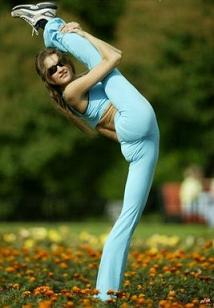How to Stretch for Strength

Flexibility training is one of the most under-utilized and under-appreciated components of fitness.
Stretching has been under constant scrutiny from fitness experts who question the role of flexibility in injury prevention. Despite the debate, athletes can enhance recovery and performance from a stretching regime, and in my opinion the right kind of stretching used at the right time definitely helps to prevent injury.
Most any powerful sports movement you can think of, can benefit from flexibility. From a football punt, to sprints, to swimming, to a tennis backswing, all intense moves need prior warm up and can often generate more power with an increased range of motion (ROM).
The simplest way to stretch for strength is to use dynamic stretching drills before exercise and modified static stretching drills after exercise. It is actually much more complex than that, so keep reading to find out more.
The Definition of Flexibility
“the range of motion of a joint and its surrounding tissues during a passive movement, which may be increased by stretching”
In this context, passive means without active muscle involvement; a static stretch. Rather than using momentum to measure flexibility, gravity, a partner, or a static hold provides the force for the stretch.
The Benefits of Flexibility Training
Simply put, a flexible athlete is a mobile athlete. Flexibility allows ease of movement around the field or court, and increases stamina and dexterity. Other benefits include an increase in bodily awareness and a relaxation in the stretched muscle groups. Both of these benefits have positive implications for skill acquisition, recovery, and performance.
By increasing range of motion in the joints before exercise, the risk of injury is reduced and performance is often enhanced. The reasons for this are because an extremity or limb can move further before a muscle pull occurs, and the increased ROM allows for greater force production.
Muscle Tightness
Associated with an increased risk of muscle tears, muscle tightness can often be reduced with dynamic stretching before training. As a result, many coaches now favor dynamic stretching over static stretching as part of pre-game or pre-competition warm up.
For example, tight hamstring muscles will restrict how high you can swing your leg. During a punt, goalie kick, roundhouse, or jump kick, your hamstrings will be compromised by the limited ROM. Swinging the leg too hard will result in a muscle pull or muscle tear, but using a limited ROM will result in limited force production. In this case the result is either subpar performance or injury.
Chronic Use and Over Use Injuries
Sports can be unbalancing at times. Quarterbacks only throw balls with one arm. In baseball, batters typically bat from only one side of the plate and players usually only throw with one arm. Tennis athletes mostly swing the racquet with one arm. Designated kickers usually only kick with one leg. See the pattern?
Flexibility training can help to correct the muscular imbalances that result from this type of uneven chronic overuse, which almost always leads to injury.
Myths and Misconceptions
A common misconception is that static stretching should be performed prior to exercise.
In the last 10-20 years, experts have discovered that this type of stretching may offer no protection from injury, and in fact static stretching before intense exercise could be detrimental to performance and could lead to an increased risk of injury.
Rather than static stretching leading to a state of muscle readiness, it actually weakens the muscle while elevating your tolerance for pain when that muscle is stretched. If you haven’t figured it out, that is a recipe for injury.
Another misconception from the opposite extreme is that no stretching should be performed before exercise.
These people tend to favor warming up by jogging or by executing sports movements with a lighter intensity. Using a lower intensity with sport specific movements begins to border on dynamic stretching, but is still not the complete solution. Real dynamic stretching will warm you up, increase flexibility, and condition your joints for the upcoming intense exercise.
Types of Flexibility
- Dynamic Flexibility – Generally more sport-specific than other forms of mobility, dynamic flexibility refers to the performance of dynamic movements within a joint’s full ROM. Some examples include twisting from side to side or kicking a ball.
- Static Active Flexibility – Referring to the ability to stretch an antagonist muscle using only the tension in the agonist muscle, static active flexibility is ideal for training the stretch-reflex, which often causes cramping when antagonist muscles are overly tight. One example is using only your leg strength to hold one leg out in front of you as high as possible. In this scenario, the quadriceps and hip flexors (agonist) are holding up the leg, which results in a hamstring stretch (antagonist).
- Static Passive Flexibility – Similar to Static Active, Static Passive is the ability to hold a stretch using body weight or some other external force. Modifying the example above, static passive flexibility is demonstrated by holding your leg out in front of you and resting it on a surface. In this case there is no active agonist, as the quads are not required to hold the stretched position.
A flexibility training program can be made up of these different types of stretching:
- Dynamic stretching
- Ballistic stretching
- Static Active stretching
- Static Passive stretching
- Isometric stretching
- Proprioceptive Muscular Facilitation (PNF) stretching
Which Type of Flexibility Training is Best For You?
It all depends on your sport of choice and your training goals.
For now, the consensus rule of thumb states that dynamic stretching should be used during warm ups and static stretching should be used during cooldowns, but never when the muscles are not warmed up.
Furthermore, coaches and trainers these days tend to favor a type of static stretching call PNF, which uses a combination of contracting, holding, and passive stretching to most effectively increase ROM.
Check out our flexibility category for several additional posts that describe the how and why for each type of stretching discussed above.
Resources
Fox, E.L. Sports Physiology. Philadelphia. Saunders. 1979
Hartig, D.E., and J.M. Henderson. Increasing hamstring flexibility decreases lower extremity overuse injuries in military basic trainees. American Journal of Sports Medicine. 27:173-176. 1999
Krivickas, L.S., Feinberg, J.H. Lower extremity injuries in college athletes: relation between ligamentous laxity and lower extremity muscle tightness. Archives of Physical Medicine and Rehabilitation. Nov;77(11):1139-43. 1996
Shrier, I. Stretching before exercise does not reduce the risk of local muscle injury: A critical review of the clinical and basic science literature. Clinical Journal of Sports Medicine. 9: 221-7. 1999
Tags: Flexibility, flexibility training, flexible, stretch, stretching, warm ups, warming up











[…] Before we really get into static stretching, you can take a minute to learn more about flexibility training. […]
[…] Before we really get into ballistic stretching, you should take a minute to learn more about the basics of flexibility training. […]
[…] Click here to learn more about general flexibility training. […]
[…] Before we really get into proprioceptive muscular facilitation (PNF) stretching, you should take a minute to learn more about the basics of flexibility training. […]
Hi I am a personal trainer at Illuminate Gym and I agree that stretching is great for recovery and warming up. The only real problem I see with stretching is people not letting their muscles get warm within the stretch or warming up before you stretch. If you’re muscles are cold and you try to push them within a stretch you could leave yourself open to injury.
You can’t see it, but I’m giving you a standing ovation. When I was coaching my daughter’s soccer team, I had two things that bugged many of the parents. First, I didn’t have them running laps. That is another article for another day. Second, no “old school” static stretching.
At first they didn’t like it, because that is what they did “back int he day”. After I explained the science behind it, they became fully supportive of dynamic warm-ups.